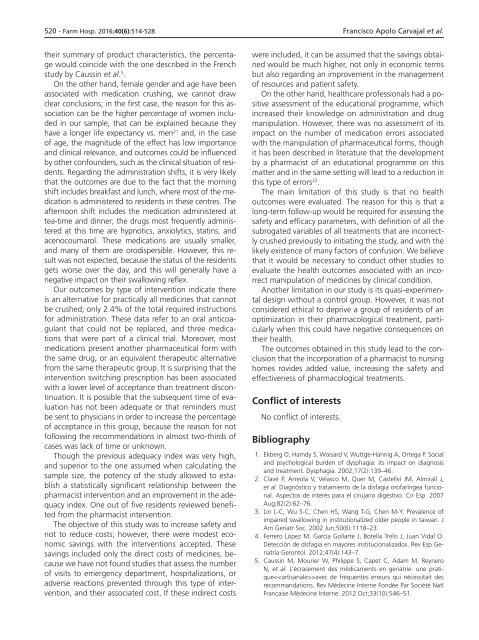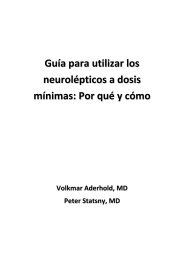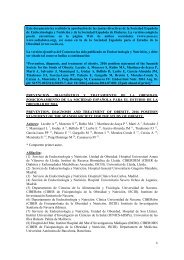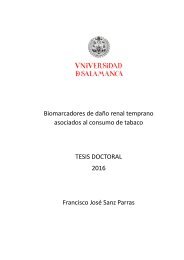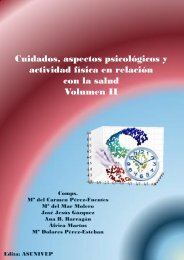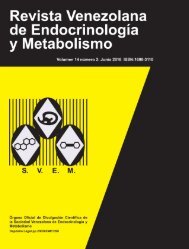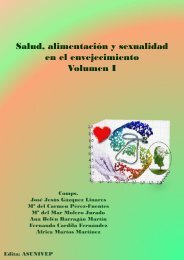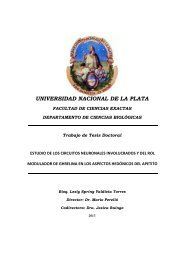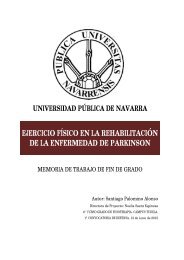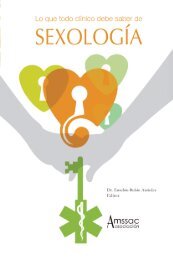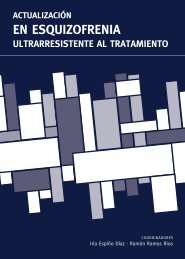Noviembre-Diciembre
156_v40n6(1)
156_v40n6(1)
Create successful ePaper yourself
Turn your PDF publications into a flip-book with our unique Google optimized e-Paper software.
520 - Farm Hosp. 2016;40(6):514-528 Francisco Apolo Carvajal et al.<br />
their summary of product characteristics, the percentage<br />
would coincide with the one described in the French<br />
study by Caussin et al. 5 .<br />
On the other hand, female gender and age have been<br />
associated with medication crushing, we cannot draw<br />
clear conclusions; in the first case, the reason for this association<br />
can be the higher percentage of women included<br />
in our sample, that can be explained because they<br />
have a longer life expectancy vs. men 21 and, in the case<br />
of age, the magnitude of the effect has low importance<br />
and clinical relevance, and outcomes could be influenced<br />
by other confounders, such as the clinical situation of residents.<br />
Regarding the administration shifts, it is very likely<br />
that the outcomes are due to the fact that the morning<br />
shift includes breakfast and lunch, where most of the medication<br />
is administered to residents in these centres. The<br />
afternoon shift includes the medication administered at<br />
tea-time and dinner; the drugs most frequently administered<br />
at this time are hypnotics, anxiolytics, statins, and<br />
acenocoumarol. These medications are usually smaller,<br />
and many of them are orodispersible. However, this result<br />
was not expected, because the status of the residents<br />
gets worse over the day, and this will generally have a<br />
negative impact on their swallowing reflex.<br />
Our outcomes by type of intervention indicate there<br />
is an alternative for practically all medicines that cannot<br />
be crushed; only 2.4% of the total required instructions<br />
for administration. These data refer to an oral anticoagulant<br />
that could not be replaced, and three medications<br />
that were part of a clinical trial. Moreover, most<br />
medications present another pharmaceutical form with<br />
the same drug, or an equivalent therapeutic alternative<br />
from the same therapeutic group. It is surprising that the<br />
intervention switching prescription has been associated<br />
with a lower level of acceptance than treatment discontinuation.<br />
It is possible that the subsequent time of evaluation<br />
has not been adequate or that reminders must<br />
be sent to physicians in order to increase the percentage<br />
of acceptance in this group, because the reason for not<br />
following the recommendations in almost two-thirds of<br />
cases was lack of time or unknown.<br />
Though the previous adequacy index was very high,<br />
and superior to the one assumed when calculating the<br />
sample size, the potency of the study allowed to establish<br />
a statistically significant relationship between the<br />
pharmacist intervention and an improvement in the adequacy<br />
index. One out of five residents reviewed benefited<br />
from the pharmacist intervention.<br />
The objective of this study was to increase safety and<br />
not to reduce costs; however, there were modest economic<br />
savings with the interventions accepted. These<br />
savings included only the direct costs of medicines, because<br />
we have not found studies that assess the number<br />
of visits to emergency department, hospitalizations, or<br />
adverse reactions prevented through this type of intervention,<br />
and their associated cost. If these indirect costs<br />
were included, it can be assumed that the savings obtained<br />
would be much higher, not only in economic terms<br />
but also regarding an improvement in the management<br />
of resources and patient safety.<br />
On the other hand, healthcare professionals had a positive<br />
assessment of the educational programme, which<br />
increased their knowledge on administration and drug<br />
manipulation. However, there was no assessment of its<br />
impact on the number of medication errors associated<br />
with the manipulation of pharmaceutical forms, though<br />
it has been described in literature that the development<br />
by a pharmacist of an educational programme on this<br />
matter and in the same setting will lead to a reduction in<br />
this type of errors 22 .<br />
The main limitation of this study is that no health<br />
outcomes were evaluated. The reason for this is that a<br />
long-term follow-up would be required for assessing the<br />
safety and efficacy parameters, with definition of all the<br />
subrogated variables of all treatments that are incorrectly<br />
crushed previously to initiating the study, and with the<br />
likely existence of many factors of confusion. We believe<br />
that it would be necessary to conduct other studies to<br />
evaluate the health outcomes associated with an incorrect<br />
manipulation of medicines by clinical condition.<br />
Another limitation in our study is its quasi-experimental<br />
design without a control group. However, it was not<br />
considered ethical to deprive a group of residents of an<br />
optimization in their pharmacological treatment, particularly<br />
when this could have negative consequences on<br />
their health.<br />
The outcomes obtained in this study lead to the conclusion<br />
that the incorporation of a pharmacist to nursing<br />
homes rovides added value, increasing the safety and<br />
effectiveness of pharmacological treatments.<br />
Conflict of interests<br />
No conflict of interests.<br />
Bibliography<br />
1. Ekberg O, Hamdy S, Woisard V, Wuttge-Hannig A, Ortega P. Social<br />
and psychological burden of dysphagia: its impact on diagnosis<br />
and treatment. Dysphagia. 2002;17(2):139–46.<br />
2. Clavé P, Arreola V, Velasco M, Quer M, Castellví JM, Almirall J,<br />
et al. Diagnóstico y tratamiento de la disfagia orofaríngea funcional.<br />
Aspectos de interés para el cirujano digestivo. Cir Esp. 2007<br />
Aug;82(2):62–76.<br />
3. Lin L-C, Wu S-C, Chen HS, Wang T-G, Chen M-Y. Prevalence of<br />
impaired swallowing in institutionalized older people in taiwan. J<br />
Am Geriatr Soc. 2002 Jun;50(6):1118–23.<br />
4. Ferrero López M, García Gollarte J, Botella Trelis J, Juan Vidal O.<br />
Detección de disfagia en mayores institucionalizados. Rev Esp Geriatría<br />
Gerontol. 2012;47(4):143–7.<br />
5. Caussin M, Mourier W, Philippe S, Capet C, Adam M, Reynero<br />
N, et al. L’écrasement des médicaments en geriatrie: une pratiqueavec<br />
de fréquentes erreurs qui nécessitait des<br />
recommandations. Rev Médecine Interne Fondée Par Société Natl<br />
Francaise Médecine Interne. 2012 Oct;33(10):546–51.


